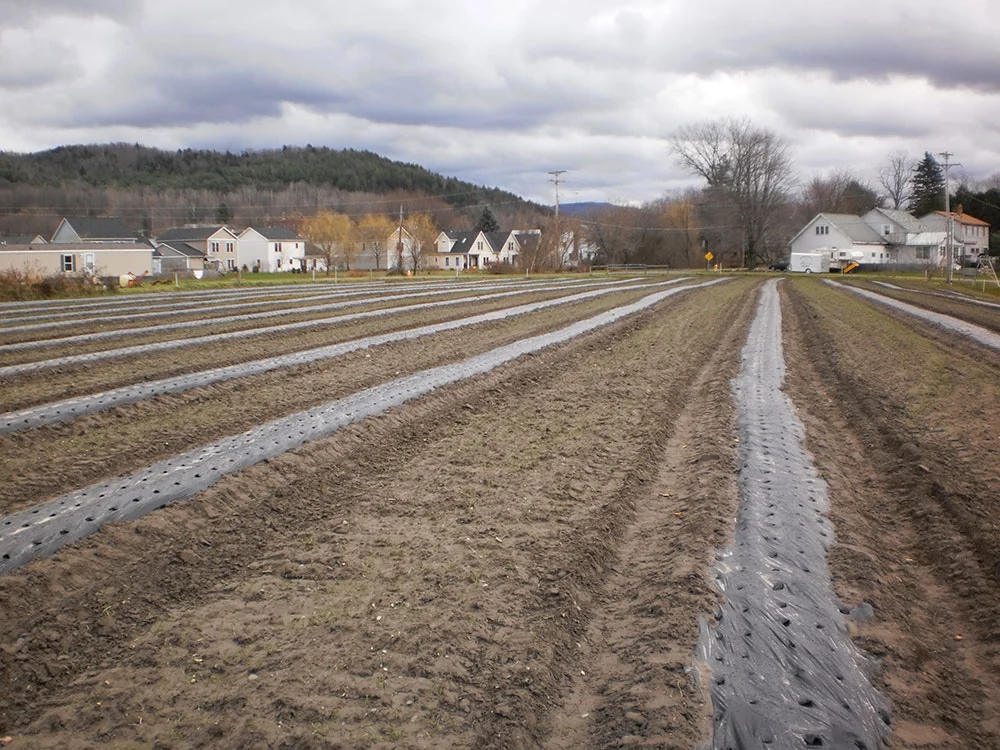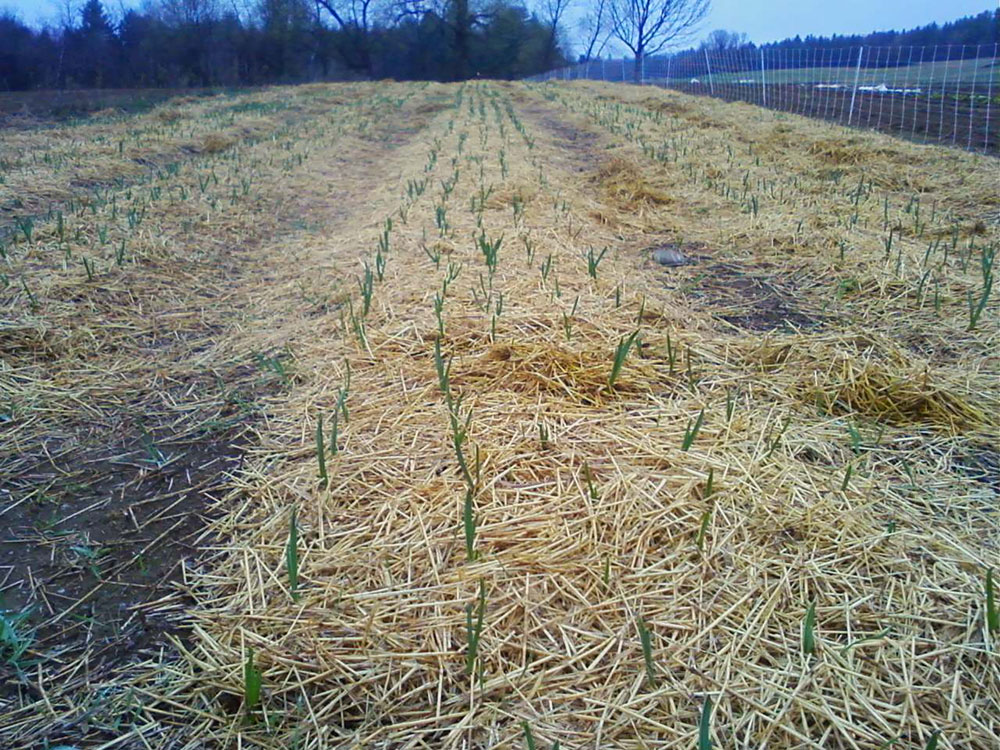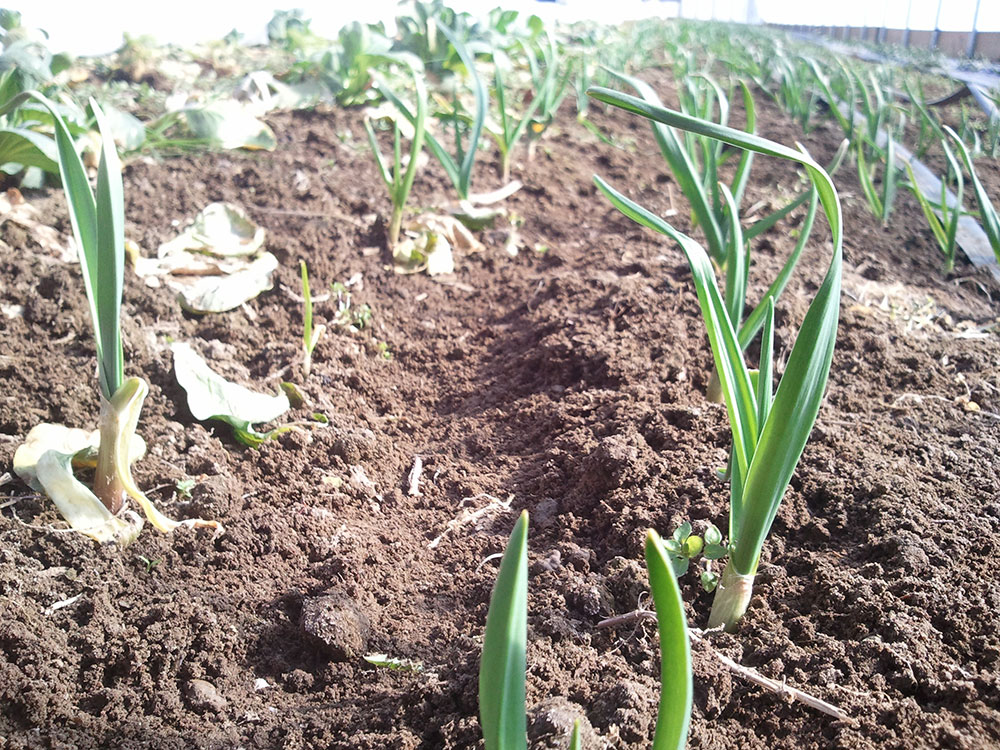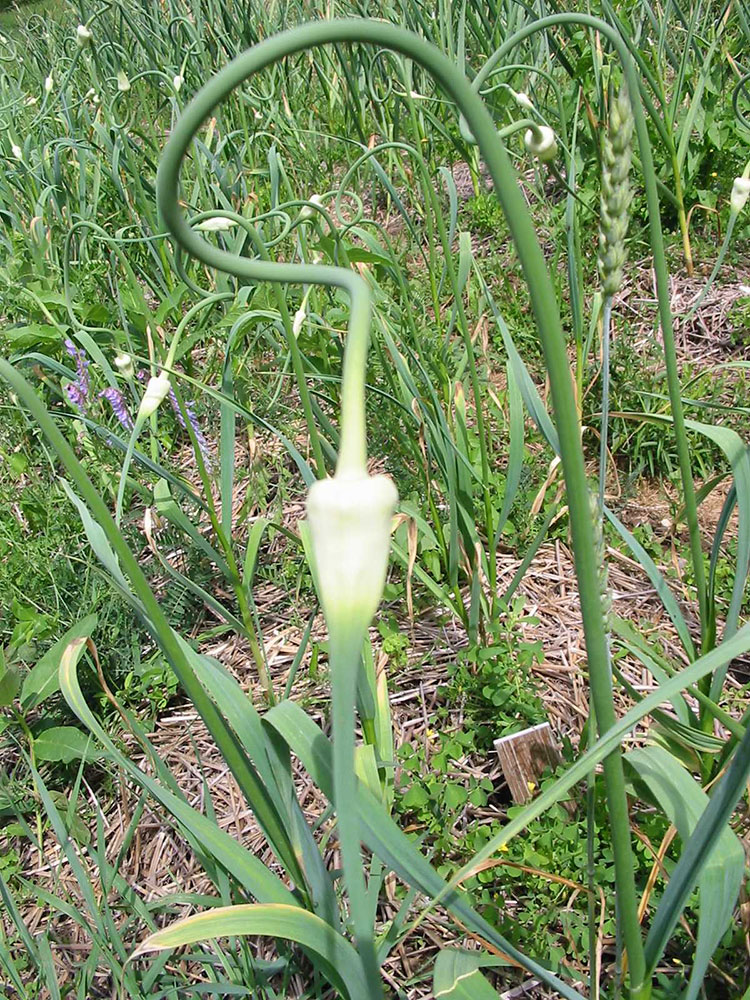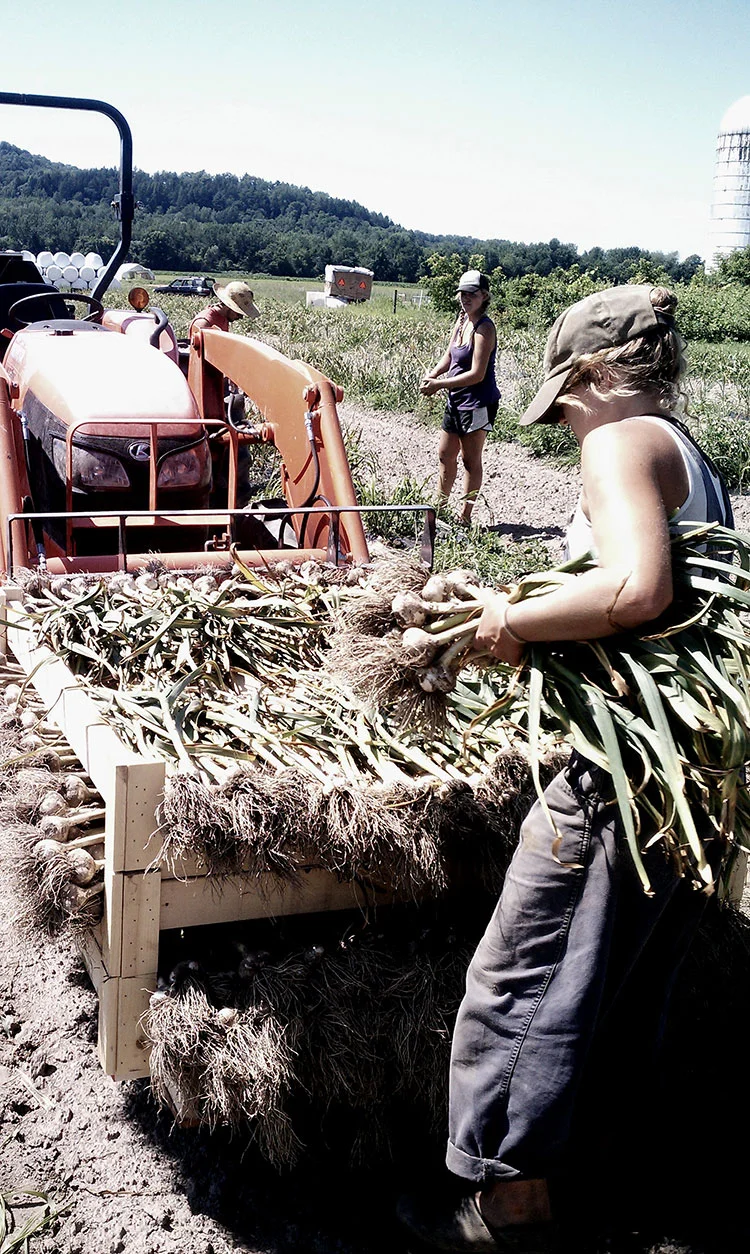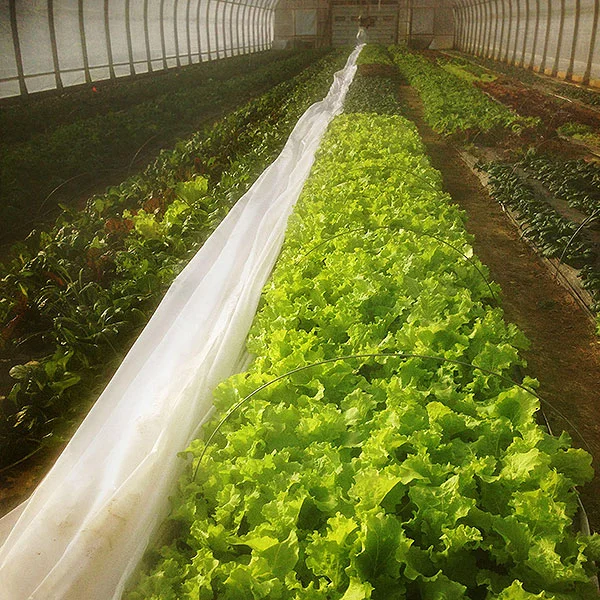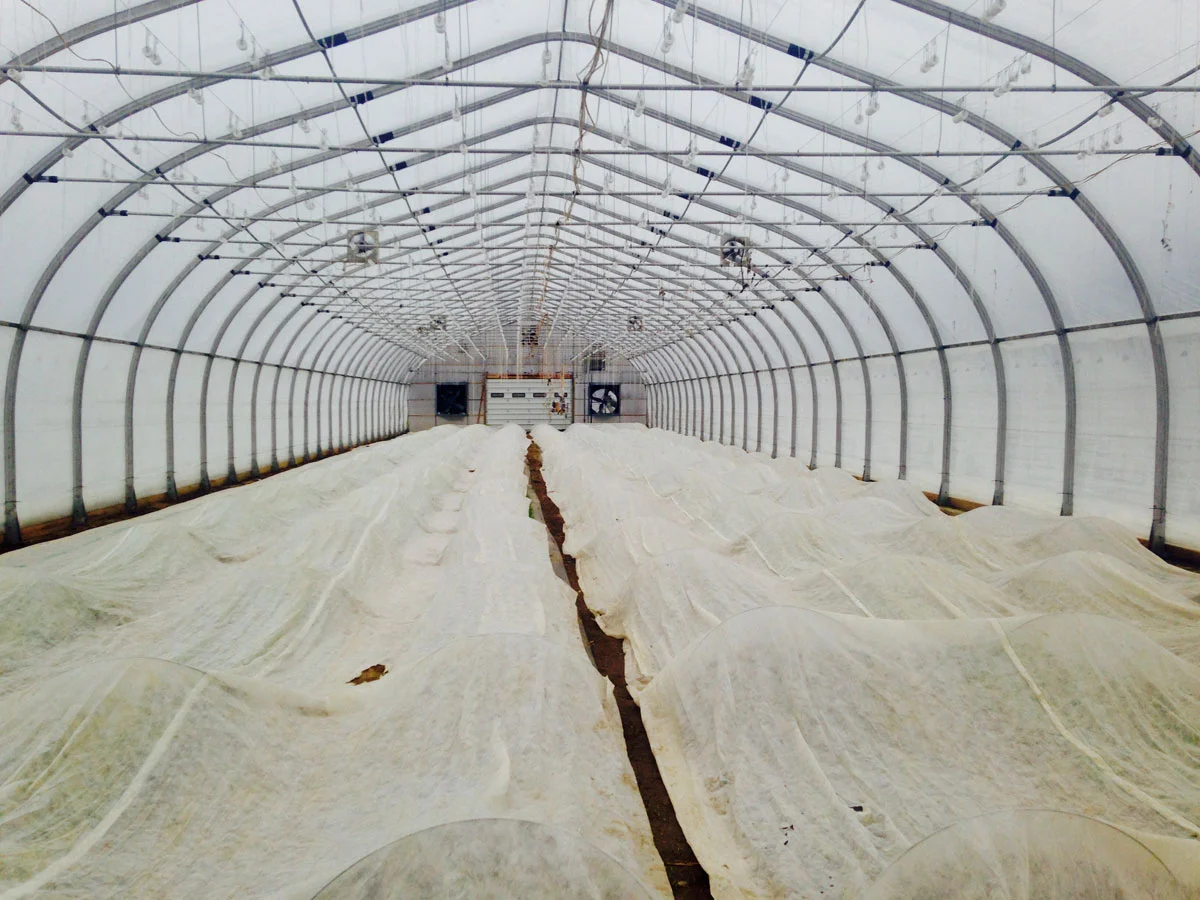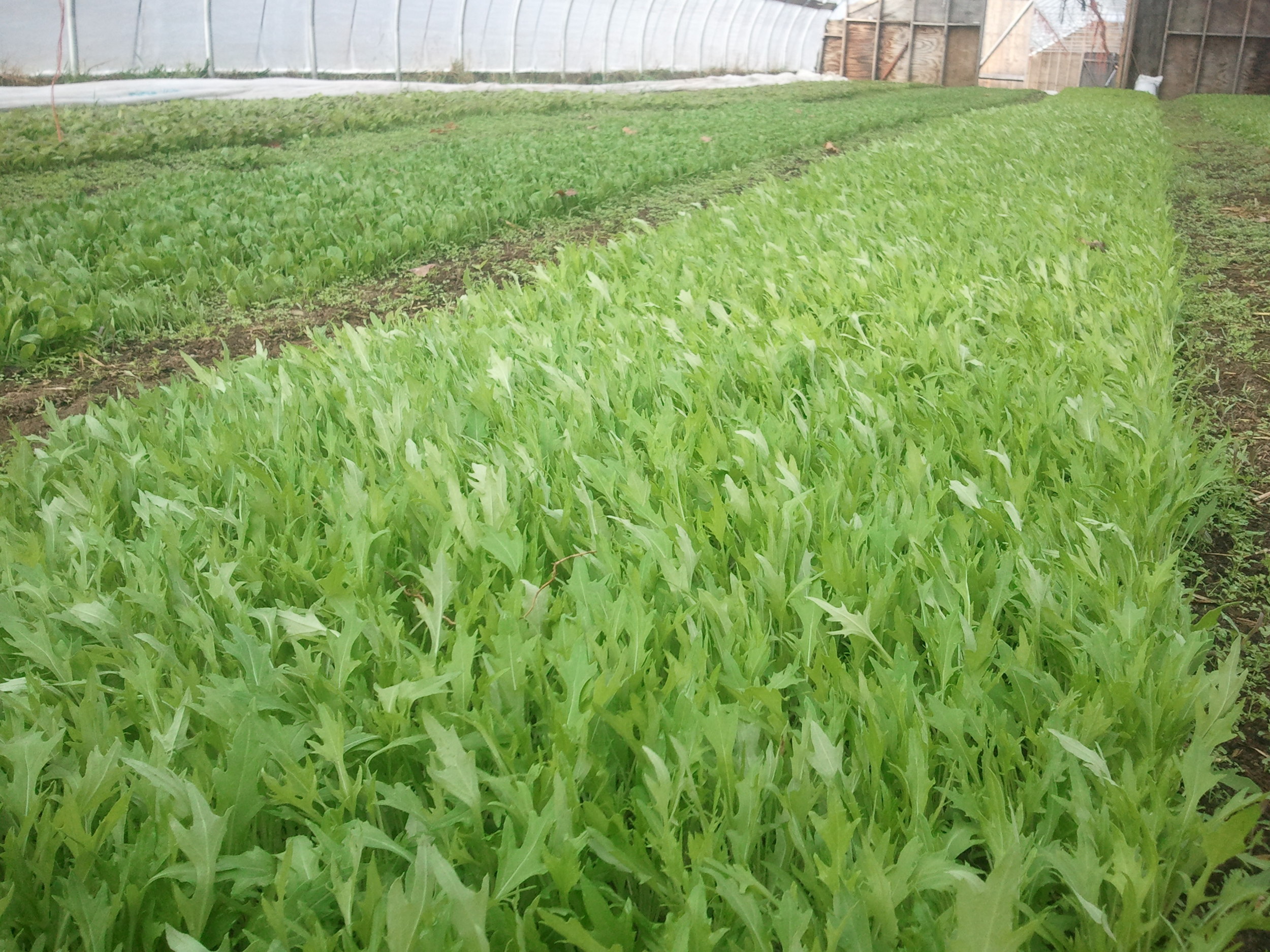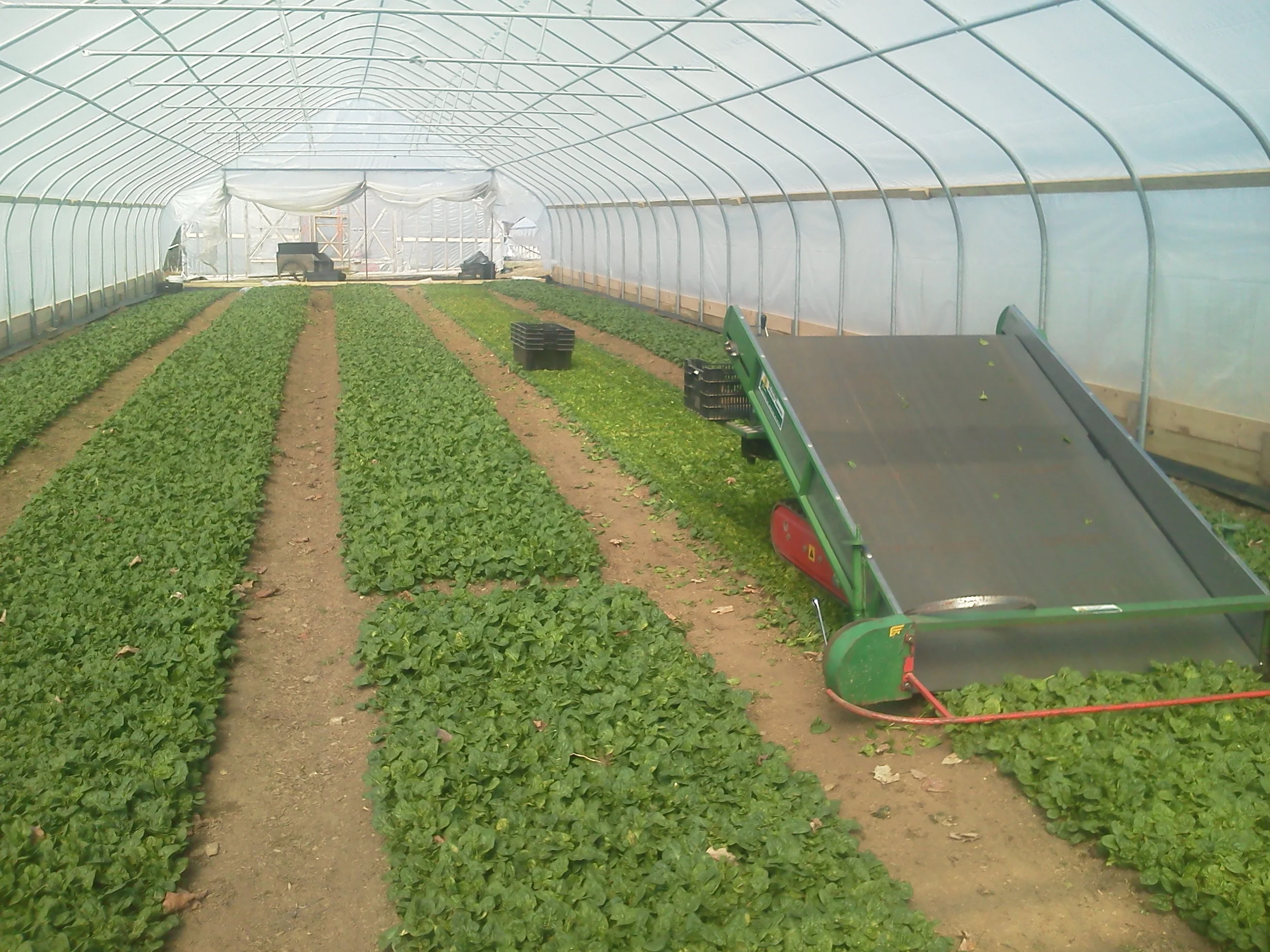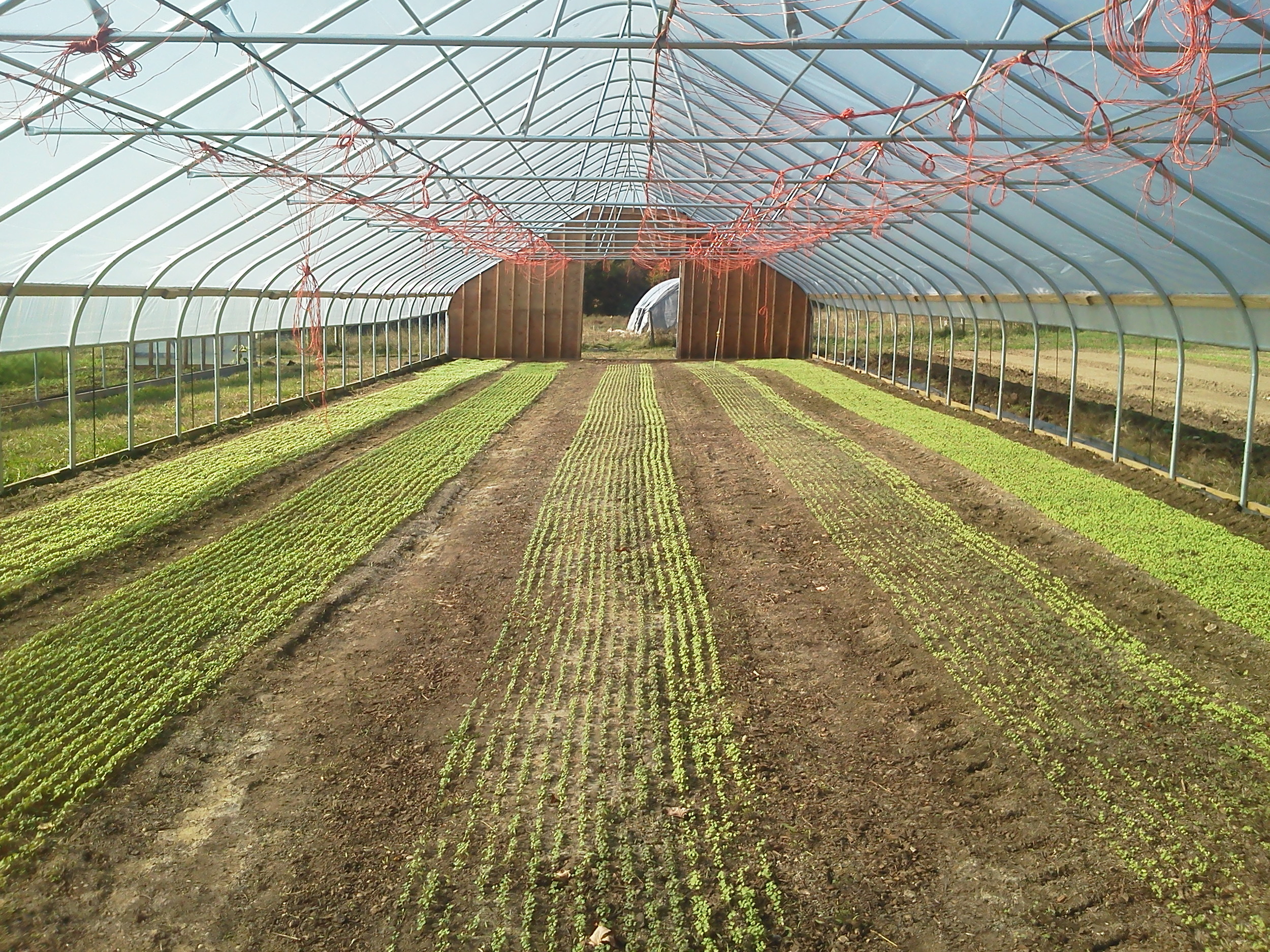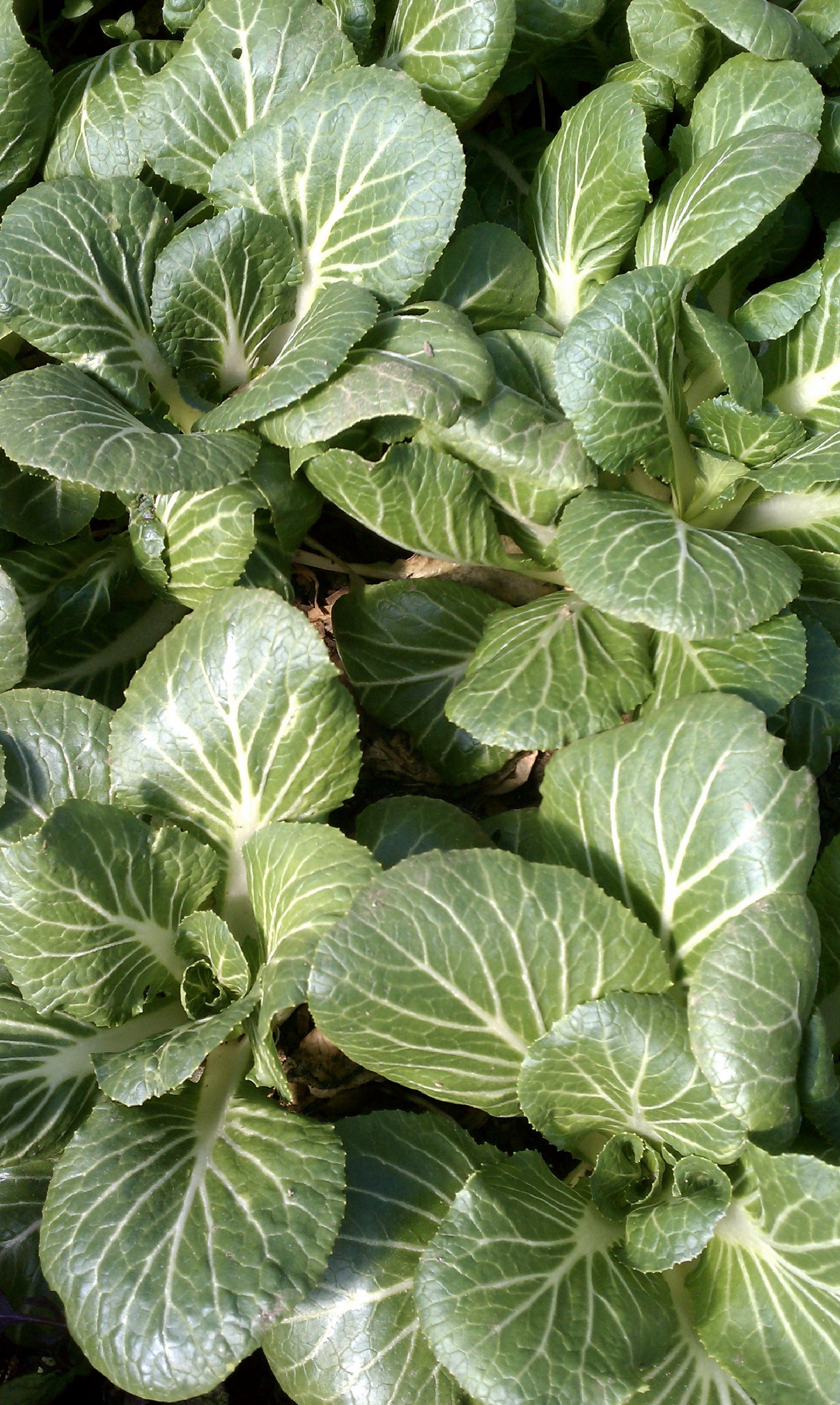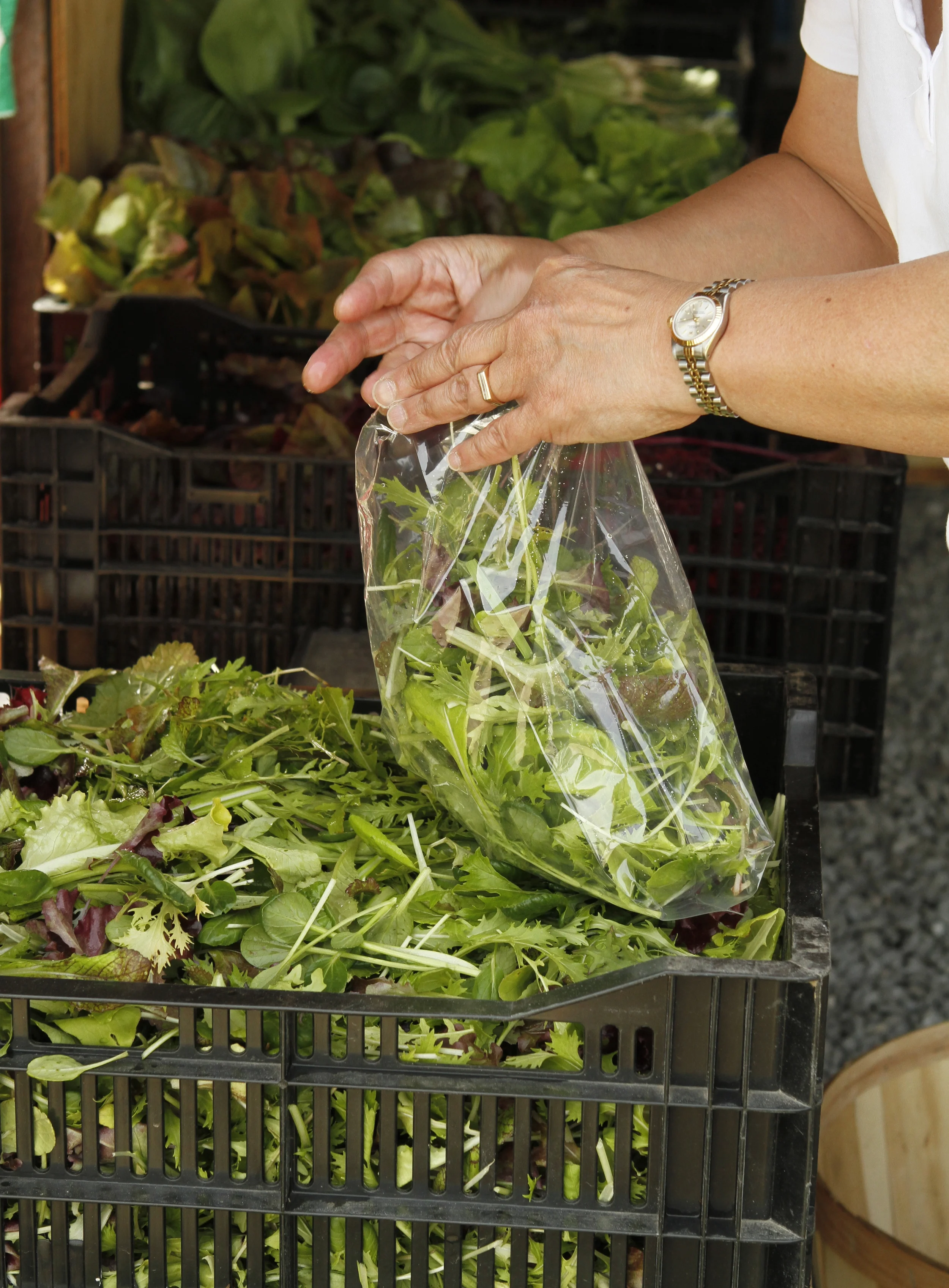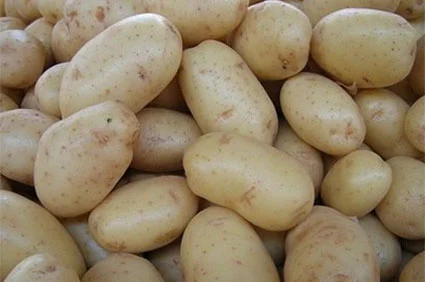The first pickups for our Spring and Year-Round CSA programs are Monday 2/29, Tuesday 3/1, and Wednesday 3/2!
Our Spring Share is known for the wide variety of early season fresh organic vegetables the we can grow, including: spinach, mesclun, microgreens, lettuce, scallions, radishes, green garlic, sweet onions, spring dug parsnips, carrots, new potatoes, and the season's first cucumbers and summer squash, plus much more! There are two share sizes available and 9 pickup sites to choose from! Round out your local eating with our Settlers Meat Medley, Chicken, Wild Alaskan Salmon, and Settlervore Shares (eggs, bread, cheese and more).
One of our favorite fall tasks is to plant garlic, which we do each November just before the ground begins to freeze. The goal is to get 8000 garlic cloves in the ground in time for them to set roots, but not too early so they don’t send up a green shoot until next spring. The JSF crew has been hard at work for the last two weeks and the cloves are snug in the soil until next spring, when they’ll be one of the first crops to break ground with their green shoots – sometimes even pushing through the lingering April snow cover.
Garlic is a member of the Allium genus (along with chives, onions, leeks and scallions). At JSF we grow several hardneck varieties as they tend to do best through Vermont’s hard winters. French Rocambole and Russian Red Rocambole are two we grow for their intense strong flavor and easy peeling qualities. Hardneck garlics have one row of cloves surrounding a prominent stem, which is called a scape. Each summer when the scape emerges and sends up a tall stalk from the middle of the plant we cut them off so the plant puts its energy into making a big garlic bulb underground, rather than growing the scape into a flower. Scapes themselves are a tasty part of the garlic plant and can be grilled, sautéed, or added to pesto. We also grow a softneck variety called Nootka Rose, as softneck varieties store for a long time through the winter, allowing us to eat garlic well into April.
Try this easy roasted garlic recipe – one of the best ways to eat garlic. Enjoy!
It’s easy to take the abundance of luscious greens coming out of the field for granted during the summer, but where do they come from this time of year? The answer is high tunnels. High tunnels are basically greenhouses in which we grow plants directly in the soil. The steel frames are covered with one or two layers of thick plastic and are warmed by passive solar heating. Two of our newest high tunnels here at Jericho Settlers Farm also have in-ground heat supplied by a biomass furnace to keep the greens happy during the coldest winter months. We have nine high tunnels at JSF and thanks to them we can grow fresh salad greens for you all winter here in Vermont.
A lot of farming has to do with timing, and seeding in high tunnels is no exception. During the summer months greens are ready to harvest roughly 20 days from seeding. But when the days start to shorten it can take up to 40 days or more to reach maturity. Seeding just a few days late can make a huge difference in the number of harvests we yield. We seed our high tunnels in late September and early October when there are still more than 10 hours of daylight for optimal germination and plant growth.
Two other important factors involved in winter growing are temperature and moisture. Both need to be monitored closely throughout the winter to ensure that the greens ending up in your salad are fresh and healthy. The plastic that covers our houses helps to trap heat from the sun, which warms the ground and aids plant growth. If it’s warm enough, we open the doors and roll up the sides of the house, which allows for airflow through the houses. On a sunny November day when it's 25 F outside it can be well over 50 F inside a high tunnel if we don't ventilate them. Keeping the plants cool (but not frozen) in the early winter helps them to harden off and be ready for deep winter, plus ventilating prevents dangerous moisture build up in the high tunnels - a precursor to fungal growth which can ruin a crop of winter greens. As the evening approaches and temperatures drop we close up the tunnels and use a lightweight cloth cover, called remay, to blanket over the vulnerable plants. By covering the salad greens and other veggies in our high tunnels we are able to trap heat from the day closer to the ground around the plants. In the morning, we're back out there again to remove the remay, ventilate the crops, and allow the sunlight to penetrate through the house to reheat the ground. Then we recover the crops in the afternoon and do it all over again the next day.
Come late December however, the combination of below freezing temperatures and short day length halts most plant growth. By this time we have harvested most of the salad greens in the unheated high tunnels and they will not regrow again until the longer sunny days of February come around. So this is when our new in-ground heated tunnel comes into real action! By maintaining minimal ground heat (with a biomass furnace) that keeps the plants just above freezing the plants are able to continue a small amount of growth even during the shortest coldest days of winter. This allows us to continue to harvest fresh salad greens through January and February.
We enjoy the change in work and growing challenges that comes along with growing during all the different seasons, even the snowy one!
We all lack cooking inspiration at one time or another, and the deep winter in Vermont certainly can present a challenge. Storage crops like beets and potatoes slowly become mundane on the dinner table. Even though these versatile, nutrient dense vegetables nourish us throughout the long winter months, we start to overlook their potential. Lately it seems like cabbage is at the top of the ‘had enough’ list. Our poor beautiful purple and green cabbage are falling prey to culinary boredom. But no more!
A little backstory for starters. Cabbage is grown annually for its densely leaved heads of eye popping purple and green. It is part of the brassica family, also referred to as a cruciferous vegetable. It has such cousins as broccoli, horseradish, cauliflower, turnips, kale and brussel sprouts to name a few. All of these and many other vegetables belonging to the same family are descendants of a non heading wild field cabbage thought to be more similar to what we think of as kale. As it evolved its popularity was partly do to its versatility, however its ability to thrive during the short northern growing seasons truly helped it become a mainstay in diets throughout the ages.
Cabbage being the humble vegetable that it is, has been a food and medicinal staple throughout history in many different cultures. Roman soldiers carried cabbage for a food sources but also used the leaves on wounds. Ancient Greeks advise eating cabbage before a night of drinking and again in the morning to help with any residual hangover. Early sea explores carried cabbage on board their ships to prevent the crew from scurvy. In modern times we still enjoy many dishes that have long histories, think sauerkraut and coleslaw. Over time human selection has given way to the dense heads we grow today.
While there are different varieties of cabbage, we grow a large crop of smooth-leaved heads that are known for their storage quality. In late spring we plant tray after tray of transplants that we have started in the greenhouse from seed. We wait for growth then we weed around the plants, then wait for more growth, and weed some more, all while watching for signs of nutrient deficiencies, plant pests, and diseases. While we do grow some early varieties of cabbage for summer enjoyment, the winter storage cabbage takes about 120 days to reach maturity for harvest. Just like our other bulk crops we harvest cabbage all at once over the course of a few days. Cabbage harvest is a crew favorite for sure. Who doesn’t love tossing cabbage and driving tractors?
Are you warming back up to cabbage yet? Check out the links in the sidebar for ideas and recipes. Hopefully you’ll find a few ideas that will help cabbage back into your good graces and onto the dinner table.
10 Recipes that Remind Us Cabbage is Awesome
If you've never made a pumpkin pie from scratch, now's a great time to try. Making fresh pumpkin puree from a sugar pie pumpkin is extremely easy and will really make your pie stand out! This recipe is from Christa's mom, Emilie Alexander, and it's incredible! One pumpkin will yield about 3 cups of puree, enough for two pies - one for dessert and one for breakfast the next day.
Ingredients:
1 pie pumpkin, cooked and pureed following directions below
For 1 pie (double for 2 pies):
1 1/2 cups pumpkin puree
1 single crust (see sidebar for a great crust recipe)
3/4 cup maple syrup (or sugar or honey)
1 tsp cinnamon
1/2 tsp ginger
1/2 tsp nutmeg
1/2 tsp salt
3 eggs
1 1/2 cups evaporated milk
1 Tbsp butter, melted
Method:
To make the pumpkin puree: Wash the pumpkin, cut it in half and scoop out the seeds and stringy inner flesh. Roast the two pumpkin halves in a baking dish lined with foil (cut side down) at 400 degrees for 50 minutes, or until flesh is tender when poked with a fork. When cool, scoop out the flesh and puree in a food processor. You can do this step ahead of time and refrigerate or freeze puree for later use.
To make the pie: Preheat oven to 450 degrees. Put the pumpkin puree in a mixing bowl and stir in maple syrup, spices, and salt. Beat eggs slightly in a separate bowl and add the evaporated milk. Combine with pumpkin mixture until well blended. Stir in the melted butter. Pour into the pie crust and bake for 10 minutes, then turn heat down to 350 degrees and bake for 35 minutes. Remove from oven and let cool fully before serving. Pumpkin pie can be made well ahead of time and refrigerated until it's time for dinner.
Want to know the best way to keep your vegetables fresh and crisp? Get the guide here!
Source: Christa's mother, Emilie
4 lbs wintersquash (about 2 Squash)
2 apples, grated
1 yellow onion, diced
1 clove garlic, minced
2 Tbsp. butter
2-3 Tbsp. maple syrup
1/2 tsp cinnamon
1/2 tsp coriander
1/2 tsp cumin
Preheat oven to 375 F. Cut squash in half lengthwise, and scrape out the seeds. Brush with olive oil and place, cut side down, on a foil lined baking sheet. Bake until squash is tender all the way through-about 30 mins.
Melt butter over medium-low heat, in a large pot or dutch oven, Add apples, onions, and cover and cook until onions are soft (about 5 mins.) Remove cover and saute until golden brown (5-7 mins). Add garlic and spices and saute until fragrant (30 seconds). Remove from heat and set aside until squash finishes roasting.
Once squash is complete, scrape it out of the skin, and add it, along with maple syrup, to the pot with the apples and onions. Whip with a hand mixer to desired consistency.
Serve hot, with a sprinkle of brown sugar.
Potato harvest is in full swing at the farm. It is one of our favorite fall tasks, bringing out the pirate kid in us as we dig for treasure. Over the next few weeks we will harvest about 5 tons of potatoes, made up of 10 different varieties. Although many potato varieties look similar to one another, each type has unique flavors and textures, which are best experienced when prepared a certain way.
White Potatoes: Kennebec
Can be round or oblong, dense in texture and mild in flavor. Potatoes in this category are popular for mashing and baking. The delicate skins eliminate the need for peeling, and they hold shape well after cooking.
Red Potatoes: Red Norland, Red Gold, Chieftain
Round and smooth potatoes, with a moist and creamy texture, and subtly sweet flavor. Red potatoes are ideal for roasting, potato salads, and use in soups. They also make some of the best "new potatoes" that we dig early in the summer.
Yellow Potatoes: German Butterball, Nicola, Yukon Gem
Medium sized potatoes with a velvety texture and a sweet, buttery flavor. Use these potatoes for roasting or grilling, to get a sweet, caramelized flavor with crispy skin. Most yellow potatoes are very versatile and can be cooked most any way. One of our favorites is German Butterball - a star potato in our Winter CSA share. It's name says it all.
Blue Potatoes: All Blue
For those that appreciate the art of vegetables, the blue potatoes round out the color spectrum. Most blue potato varieties are soft and fluffy in texture.
Fingerlings: Red Thumb, Banana, Magic Molly
Fingerlings are oblong potatoes that tend to be smaller in size, with a firm texture. They are earthy, nutty, and buttery in flavor - the best for pan-frying, and roasting. And they come in all colors - we grow a red one, a gold one and a purple one.
September has begun, and you can really feel the seasons beginning to change. The days are getting a little shorter, the days are just about to cool off, and the leaves are just starting to turn. September has brought some exciting changes to the farm as well, check them out!
Fall is here, and so are Delicata and Acorn squash! These little beauties are perfect for baking and roasting- get your fill at our farmstand!
These delicate little gourds shown above go perfectly with the falling leaves. A delightful addition to your porch, table, or bedroom.
Wintersquash and Pumpkins aren’t quite ready yet, but we’re starting to see some early color. Keep yours eyes peeled in the coming weeks, because they will be here soon!
Lastly, pumpkins and leaves aren’t the only things changing color around here...Check out our vibrant peppers!
Every summer we produce thousands of pounds of tomatoes at Jericho Settlers Farm, of all colors, sizes, and flavors. Fresh tomatoes in the summer are truly a treat for both the eyes and the stomach. And even better, they are super good for you! Tomatoes are considered a “functional food", meaning they do more than just provide basic nutritional and caloric needs. They also contain certain nutrients that can help prevent chronic diseases and heal and strengthen our bodies. Here are just a few of the amazing vitamins and minerals found in tomatoes, and what they do for you!
- Lycopene: a free-radical trapping anti-oxidant
- High levels of Calcium and Vitamin K: essential for strong bones!
- Vitamin B and Potassium: help reduce cholesterol and lower blood pressure
- Vitamin A: helps strengthen our eyes!
- Vitamin C: important for skin health, effective at healing sun damage
- Chromium: a nutrient that regulates blood sugar
- Bioflavonoids and Carotenoids: reduce inflammation, which can help minimize chronic pain.
Can’t get enough of these edible powerhouses? Stop by our farmstand and stock up on fresh red slicers, cherry tomatoes, saladettes, and heirlooms. And enjoy the nutritional benefits and summer fresh flavor of JSF tomatoes year round by picking up a few flats to can or freeze into delicious sauce, paste, or salsa that you can enjoy all winter long.





